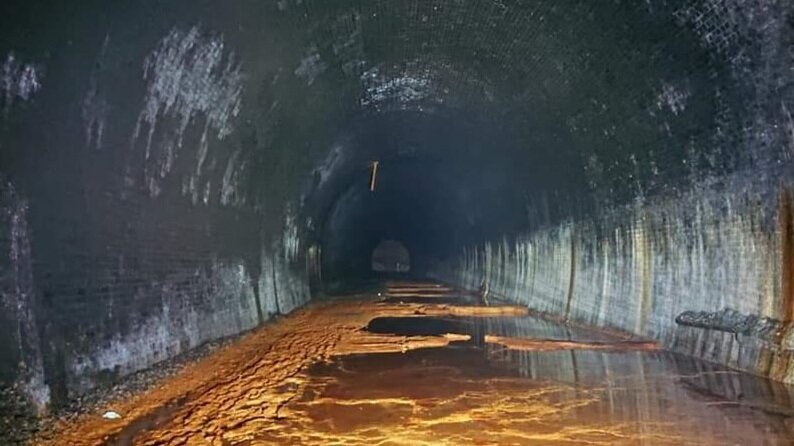It is quite surprising to discover how many people are interested, like me, in the exploration of disused and abandoned railway lines, and there are numerous Facebook groups and YouTube channels catering for this interest, which I regularly enjoy delving into.
A chance encounter with the photograph posted below has taken me on the most wonderful journey into both darkness and illumination, giving rise to an initial series of drawings which I am now grouping as a collection entitled “Tunnel Visions”.
Abandoned railway tunnel, UK. Author: unknown.
Please contact me if this is your photograph. I will be very happy to credit you.
There is so much to inspire me in this eerily beautiful photograph of a place most of us never see: the enticing perspective of the tunnel receding into darkness, the mark-making of the mineral leaching on the brickwork (calcites, in this case, I believe) and of course that amazing copper reflectivity of the spoil and water on the tunnel floor. I think this is a result of oxidisation, rendered gloriously copper-like when illuminated. (Many old tunnels contain dumped spoil and waste from other industrial sites such as mining or construction.)
Naturally, this also resonates perfectly with my current artistic practice: the exploration of Britain’s industrial heritage, an interest in the processes of decay and damage, my love of copper, and the delicate interface between remembering and forgetting.
There were plenty more amazing photographs to be inspired by, of course. In fact, my very first response to this new and enticing subject was inspired by a photograph taken looking vertically upwards through a tunnel ventilation shaft:
Mark Clay: “Standing in the place between forgetting and remembering.” (2021)
Ink on paper, H42cm square.
In this drawing I was using the strong sense of perspective as a way of thinking about time and processes of decay. As with its source photograph, it is a view from the position of the viewer on the tunnel floor looking up and out through the ventilation shaft as drops of water fall downwards from above. And, as a flat drawing, it can be read as movement in two directions: from the precise brickwork of the centre of the drawing outwards to increasing fragmentation and abstraction; or in the opposite direction. It is this quality of liminality, of things changing from one thing to another, that gave rise to the title of the piece, “Standing in the place between forgetting and remembering.”, because like so much of my work it is, fundamentally, about encounters with remembered things that stand on the cusp of being forgotten. That also plays out, I hope, in the equal sense of this being both a representational drawing and an abstract one, at the same time.
I also wanted to imbue a sense of both precision and decay. A railway tunnel is a precise, engineered creation, a carefully calibrated tube of emptiness carved through the earth and bound by uncountable pieces of regular brickwork (or other materials in the modern day). I used a compass to capture that quality. But I also allow that rigour to decay and break down, through disrupting and reducing the lines, and through the use of a dip-pen and ink, with its associated risks of blots and smudges. Together, I think the two combine to make something quite dynamic and interesting.
A gallery of series will follow in due course as the series develops further.

